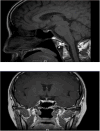Challenges in autoimmune polyendocrine syndrome type 2 with the full triad induced by anti-programmed cell death 1: a case report and review of the literature
- PMID: 38707904
- PMCID: PMC11067522
- DOI: 10.3389/fimmu.2024.1366335
Challenges in autoimmune polyendocrine syndrome type 2 with the full triad induced by anti-programmed cell death 1: a case report and review of the literature
Abstract
Background: Immune checkpoint inhibitors (ICPis) induce autoimmune diseases, including autoimmune polyendocrine syndrome type 2 (APS-2), which is defined as a combination of at least two of the following endocrinopathies: autoimmune thyroid disease, type 1 diabetes, and Addison's disease. Cases with the full triad are rare. We present a case of an elderly woman who developed APS-2 with the complete triad shortly after starting anti-programmed cell death 1 (anti-PD1) treatment and review the related literature.
Case: A 60-year-old woman, without any personal or family history of autoimmune and endocrine diseases, started the immunotherapy of anti-PD1 (camrelizumab) for squamous cell carcinoma of the urethral meatus. She developed primary hypothyroidism with elevated antibodies to thyroid peroxidase and thyroglobulin after 25 weeks of treatment, and developed primary adrenal insufficiency with adrenal crisis and fulminant type 1 diabetes with ketoacidosis after 45 weeks. Therefore, this patient met the diagnosis of APS-2 and was given multiple hormone replacement including glucocorticoid, levothyroxine and insulin therapy. Continuous improvement was achieved through regular monitoring and titration of the dosage.
Conclusions: Different components of APS-2 may appear at different time points after anti-PD1 administration, and can be acute and life-threatening. A good prognosis can be obtained by appropriate replacement with multiple hormones.
Insights: With the clinical application of ICPis to APS-2, the complexity of its treatment should be paid enough attention.
Keywords: adrenal crisis; adrenal insufficiency; anti-programmed cell death protein 1; autoimmune polyendocrine syndrome type 2; hypothyroidism; type 1 diabetes mellitus.
Copyright © 2024 Pan and Li.
Conflict of interest statement
The authors declare that the research was conducted in the absence of any commercial or financial relationships that could be construed as a potential conflict of interest.
Figures




Similar articles
-
Anti-programmed cell death protein 1 (anti-PD1) immunotherapy induced autoimmune polyendocrine syndrome type II (APS-2): a case report and review of the literature.J Immunother Cancer. 2019 Sep 5;7(1):241. doi: 10.1186/s40425-019-0713-y. J Immunother Cancer. 2019. PMID: 31488221 Free PMC article. Review.
-
Autoimmune polyendocrine syndrome type 2 in children: a case report and literature review.BMC Pediatr. 2025 May 2;25(1):351. doi: 10.1186/s12887-025-05697-3. BMC Pediatr. 2025. PMID: 40316945 Free PMC article. Review.
-
ICPis-Induced Autoimmune Polyendocrine Syndrome Type 2: A Review of the Literature and a Protocol for Optimal Management.J Clin Endocrinol Metab. 2020 Dec 1;105(12):dgaa553. doi: 10.1210/clinem/dgaa553. J Clin Endocrinol Metab. 2020. PMID: 32905579 Review.
-
Adrenocortical Crisis Triggered by Levothyroxine in an Unrecognized Autoimmune Polyglandular Syndrome Type-2: A Case Report with Review of the Literature.Curr Drug Saf. 2021;16(1):101-106. doi: 10.2174/1574886315666200826095842. Curr Drug Saf. 2021. PMID: 32851966 Review.
-
A case report of anti-GAD65 antibody-positive autoimmune encephalitis in children associated with autoimmune polyendocrine syndrome type-II and literature review.Front Immunol. 2023 Nov 22;14:1274672. doi: 10.3389/fimmu.2023.1274672. eCollection 2023. Front Immunol. 2023. PMID: 38077387 Free PMC article. Review.
Cited by
-
Sintilimab-induced diabetes mellitus and thyroid dysfunction in patient with gastric adenocarcinoma: A case report and literature review.Medicine (Baltimore). 2025 May 16;104(20):e42490. doi: 10.1097/MD.0000000000042490. Medicine (Baltimore). 2025. PMID: 40388765 Free PMC article. Review.
-
Delayed diagnosis of the full triad autoimmune polyendocrine syndrome type 2 with adrenal crisis: a case report and literature review.Front Immunol. 2025 May 9;16:1563629. doi: 10.3389/fimmu.2025.1563629. eCollection 2025. Front Immunol. 2025. PMID: 40416965 Free PMC article. Review.
-
Cognitive Impairment Caused by Isolated Adrenocorticotropic Hormone Deficiency Mimicking Dementia with Lewy Bodies.Intern Med. 2025 May 1;64(9):1419-1422. doi: 10.2169/internalmedicine.4232-24. Epub 2024 Oct 4. Intern Med. 2025. PMID: 39370251 Free PMC article.
References
-
- Barroso-Sousa R, Barry WT, Garrido-Castro AC, Hodi FS, Min L, Krop IE, et al. . Incidence of endocrine dysfunction following the use of different immune checkpoint inhibitor regimens: A systematic review and meta-analysis. JAMA Oncol. (2018) 4:173–82. doi: 10.1001/jamaoncol.2017.3064 - DOI - PMC - PubMed
Publication types
MeSH terms
Substances
LinkOut - more resources
Full Text Sources
Research Materials
Miscellaneous

